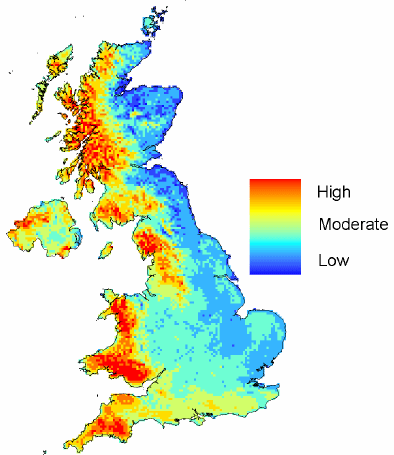Trees in the UK are facing significant threats on two major fronts. The warming climate is making new territories habitable for unwanted pests and pathogens; while our insatiable appetite for the newest or cheapest plants and woody materials, imported via global trade, is making the situation ever worse.
Global trade
The massive growth in the global trade of plant material has led to a steady increase in the number new economically or environmentally-damaging plant pests and diseases, and incidentally invasive ‘alien’ species too. These can be brought in on small container-grown or bare-root nursery material, or increasingly on large (e.g. 10m tall) trees planted in landscaping schemes.
The pathogen responsible for Sudden Oak Death (Phytophthora ramorum) is a recent example of a serious alien pest and disease that has been introduced (read more). Others include the oak processionary moth and horse chestnut leaf miner.
The wood trade is another potential vector for pests and diseases. Currently there is an aim to halt import of Birch timber (Betula spp.) because of the threat from the Bronze Birch Borer (Agrilus anxius); a pest native to North America.
Climate change and tree pests/pathogens

The establishment of new pests and pathogens has been helped by milder and wetter winters in recent decades, and the situation is predicted to get worse.
The map (left) shows risk modelling by scientists at Forest Research for Phytophthora kernoviae and P. ramorum (sudden oak death) in the UK. This was based on an average annual climate for the UK using parameters adopted in predicting the disease development in California by Meentemeyer et al. 2004 (see ref below). By considering climate factors such as rainfall, maximum and minimum temperature and relative humidity, it seems that the western fringes of the UK are most at risk. However, it is important to note that such modelling does not consider current host distribution and abundance, nor microclimates.
A recent scientific article by Netherer and Schopf (see section below) studied the potential effect of climate change on insect pests, using the oak processionary moth as a case study. It seems that in southern European conditions will become generally less suitable for tree pests (and the trees!) due to increased drought and wild fires, while current northern limits will shift northwards in latitude. New pests and pathogens are therefore likely in boreal forests of continental Europe and in other new areas such as the UK. So a combination of favourable climate with the help of man in the global trade of materials is a lethal combination for our trees.
Risk management in the UK
The UK Government established the Forestry Commission Biosecurity Programme Board in 2010. Its aims are to:
“Preserve the health and vitality of our forests, trees and woodlands through strategies which exclude, detect, and respond to, existing and new pests and pathogens of trees, whether of native or exotic origin.”
Gabriel Hemery
Read more
Hemery, G.E. et al., (2010). Growing scattered broadleaved tree species in Europe in a changing climate: a review of risks and opportunities. Forestry 83, 1: 65-81. Read
Meentemeyer, R., et al. (2004). Mapping the risk of establishment and spread of sudden oak death in California. Forest Ecology and Management 200, 195–214. Read
Netherer, S. and Schopf, A. (2010). Potential effects of climate change on insect herbivores in European forests – General aspects and the pine processionary moth as specific example. Forest Ecology and Management. 259: 831–838. Read
Take action: sign up to TreeWatch.com
 This work is licensed under a Creative Commons Attribution- NonCommercial- NoDerivs 3.0 United States License.
This work is licensed under a Creative Commons Attribution- NonCommercial- NoDerivs 3.0 United States License.
